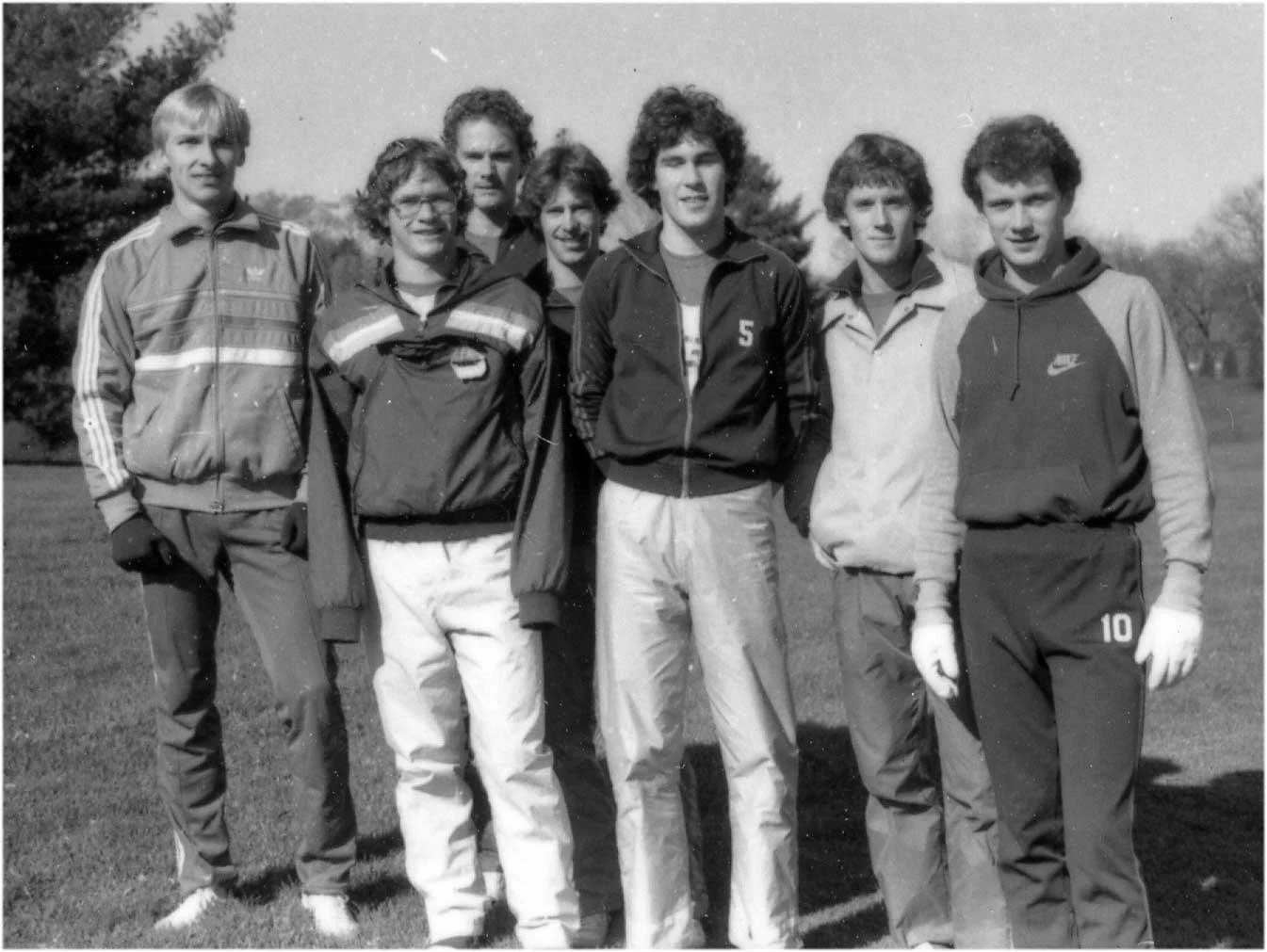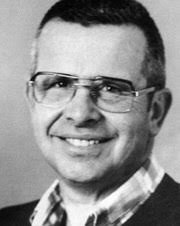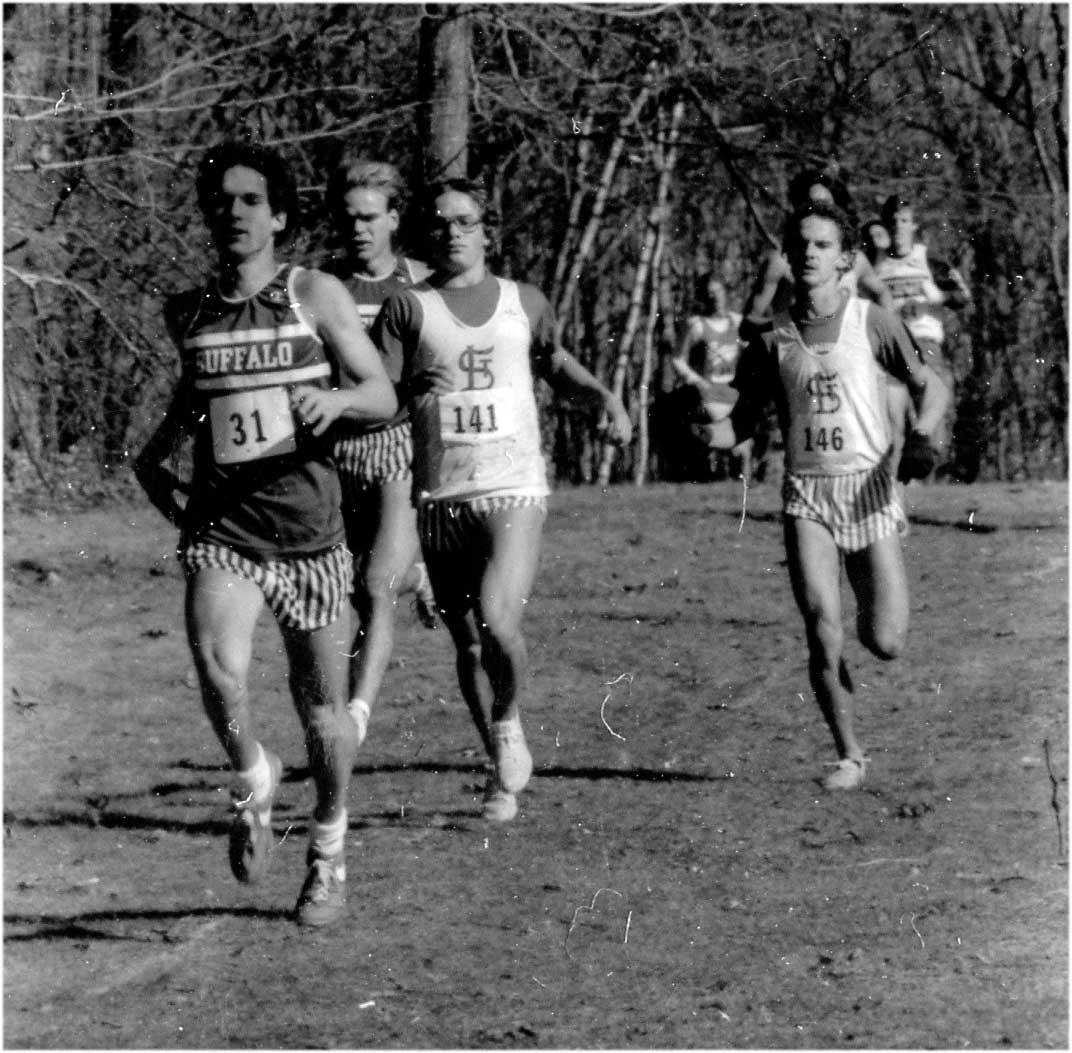1985 St. Lawrence University Cross Country
“This is the year,” Doc tells his team from his bed. The Saint Lawrence cross country team is gathered at Doc’s house, visiting him for another time this season.
Ronald “Doc” Hoffman is sick with skin cancer. The ex-football player has deteriorated to 100lbs and is unable to walk. Only his voice remains unchanged. “This is the year,” he insists again with loud enthusiasm.
The team knows what he is referring to. SLU has never won the cross country state championship, and Doc believes they will win this year. And he is determined to live until they do.
Predicted to take no better than third, the team doesn’t think it’s possible. The state meet is only a month away.
“What’re we going to do?” Tom Thorp asks the guys as they shuffle out of Doc’s house. No one has an answer.
St. Lawrence Cross Country Team
A Team of Locals
Known for his close-to-home recruiting, Doc gave locals a chance to grow in his program. SLU is located in northern New York, and many of its athletes come from the surrounding area, from Watertown to Westville. According to Thorp, “Doc owned the North Country back then.”
Since Thorp is from Albany, NY, he had never heard of SLU until Doc sent him letters describing the running program and inviting him to visit. Ultimately, he decided he could succeed on their track team.
The team also had one runner from Finland, Jukka Tammisuo. Doc joked to the local newspaper that he included Tammisuo with the northern boys because “you don’t get much farther north than Finland.”
Aside from Thorp and Tammisuo, the remainder of the team were true North Country boys. Marty Dumoulin was from Massena, Robert “Duncan” Douglas from Potsdam, Tony Bjork from Ogdensburg, Dean Burns from Watertown, and Norman Pomainville from Westville.
Map of northern New York
Pomainville had also never heard of SLU. He ran cross country in high school but had no plans to run in college. That is until Marc “Goose” Gosselin saw him run a 5k.
Gosselin had run for Malone, NY’s high school team, and ran for SLU at the time. After seeing Pomainville run, he thought he should introduce him to Doc, the Saints’ head cross country coach.
The next day, Gosselin brought Pomainville to meet Doc at Camp Canaras, a summer camp in Saranac Lake, NY. It wasn’t a running camp, but Gosselin and Dumoulin worked and trained there during the summer.
Pomainville went on a run with the two SLU athletes at Canaras. He didn’t know it was a test, but afterward, Doc told him he would be a good fit for the SLU team. He wasn’t the best runner, but he was a local and a hard worker.
After their run, Doc had the guys transplant small trees. He wanted the trees moved from crowded and shady areas into the sun so they would have a chance to grow.
Doc believed his athletes were like these trees. While they might not be great initially, they could become exceptional runners when given the opportunity and resources. With this philosophy, Doc coached his team of locals to success.
1984
Doc was the opposite of calm and collected. When he yelled, it was more of a bark. Imagine a regimented coach standing in a grass field with a whistle.
As a hall-of-fame football player at SLU, Doc was not a typical running coach. He didn’t know much about training, and his talent as a coach came more from his heart than his head.
Ronald “Doc” Hoffman
His most successful season was in 1984, when he was named into the hall of fame. That year, his team had an 8-0 dual meet mark; won the regional meet, the conference meet, and a big invitational; and took second at the state meet to Sienna.
Siena and SLU had a rivalry in the ‘80s. Siena was a D1 school and the best team around. According to Thorpe, they were the “golden standard,” and Doc wanted to beat them badly.
Before the 1984 state meet, Doc held a meeting to motivate the team. He told them their performances at states would determine who went to nationals. Writing their names on a chalkboard, he talked about each athlete’s merits. When he got to Pomainville, he said, “Norm’s a goddamn horse.”
After the state meet, the national’s team was decided. Douglas hadn’t made the cut. Possibly with a hint of resentment, he began training for the following year.
Robert “Duncan” Douglas and Norman Pomainville
1985
Before the 1985 season, Doc introduced Paul Daley as SLU’s new head coach. He was too sick to continue coaching.
“This is the year,” Doc said, riled up about beating Siena at the state meet, despite his illness.
With his team of locals running better than ever, his excitement was natural. A local newspaper reports that Doc “won just about every cross country title New York State has to offer in his coaching tenure… except one.” Maybe this was the year.
Doc’s health continued to deteriorate until he couldn’t leave his bed. Yet, he hung on, determined to see the day the Saints won the state championship.
Visiting him often, the team saw their 53-year-old coach transform into a frail old man.
Unfortunately, Doc didn’t make it. He passed away in his home on October 15, less than a month before the state meet. Now, the stakes were raised.
In honor of their coach, the guys wore black bands on their singlets, but no one said anything out loud about winning for Doc.
Tony Bjork and Norman Pomainville running with black bands on their singlets
The state meet was at the University of Rochester on Saturday, November 2. The meet hosted 20 teams from New York, including public and private schools from every division.
The defending champion was Sienna; a D1 team predicted to win again. SLU was projected to take no better than third. But, the Saints were inspired and motivated to run hard.
Tammisuo, their star runner, was usually at the front of big races. He placed fourth with a time of 25:33. Dumoulin finished close behind with a 25:48, taking sixth. Douglas, who wasn’t usually in the top pack, pulled through with a 25:58, taking ninth.
Thorpe, a 1:51 800m runner, ran a strategic race. Mid-race, he pulled up on the pack of Bjork, Burns, and Pomainville, encouraging them to work harder and make their way up.
Pack running is important for points in cross country, and Bjork, Burns, and Pomainville usually worked together. Finishing within one second of each other, with times of 26:36 and 26:37, the three men rounded out SLU’s score.
The guys didn’t think they had any chance to win until they saw what Douglas had done. Placing higher than expected, his training from the year before had paid off.
The team knew the scores would be close. As the points were counted, they began to get anxious anticipating the results. Do we have a chance?
Then it was announced: the Saints had won the cross country state championship for the first time in SLU history. With their top six ahead of Ithaca’s fifth, they won by only six points. Ithaca took second with 90 points, and Siena took third with 94.
The Saints went crazy. For the first time that season, they felt joy. Out of character, they began cheering and high-fiving each other. It was all a blur.
Their energy was high on the cool down and the ride home. They were still high-fiving each other when they returned to campus. Can you believe it?
It was “a real shock that we won,” Thorp said. The guys felt they had no chance, but the season’s circumstances inspired them.
Only Doc, who had never run in his life, had believed that his team of locals had what it took to win the title.
A local paper reports, “the saint's first-ever state championship title this fall can be considered a final honor to Hoffman.” It was true; Doc believed in his team until the end.
Despite passing away shortly before the state meet, Doc’s dreams became a reality. This was the year.












